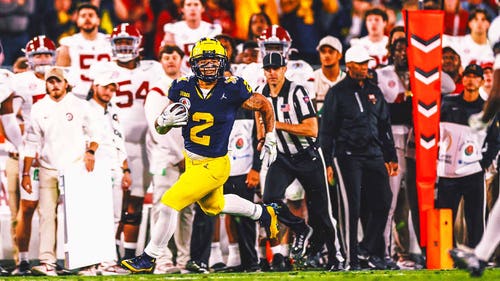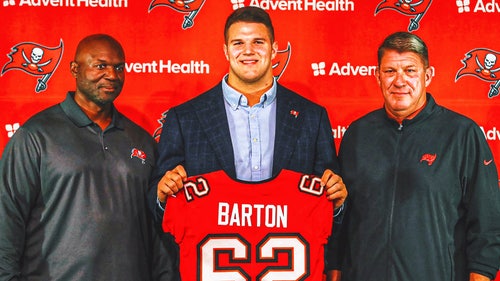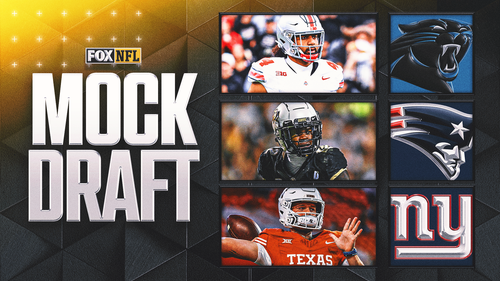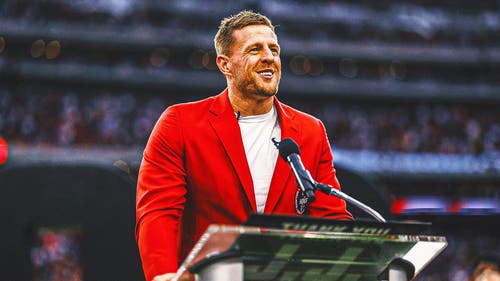
Panthers' Olsen, family draw inspiration from young son battling heart condition
At first glance, the birthday party unfolding inside the Olsen home Thursday evening seemed simple enough. Perhaps even underwhelming by today's standards -- two blond-headed twins not completely grasping the concept of turning two years old, but nonetheless gleefully and innocently soaking in the candles, cupcakes, and attention of just a few close family members.
The event was momentous, however, for the adults in the room, especially the twins' parents, Kara and Greg Olsen. The Carolina Panthers star tight end and his wife have agonized over whether both their twins -- daughter Talbot and son TJ -- would be here to celebrate this day.
TJ suffers from a congenital heart defect called hypoplastic left heart syndrome, which means the left side of his heart is severely underdeveloped.
TJ has already endured four surgeries -- three open heart procedures and the installation of a pacemaker. He's spent almost as much time living in the hospital as he has at home. After a hospital stay that lasted more than a month following the third open heart surgery and the pacemaker, TJ arrived home two and a half weeks ago, hopefully for good. There is, however, a 25 percent chance TJ will still need a heart transplant.
"Having all three surgeries past us just before the twins' birthday is an inexplicable feeling -- relief and pure happiness," Kara Olsen said. "We now have a true understanding of how to cherish our moments together. We made their birthday very simple. It meant so much just to be together, under one roof, happy and healthy."
Greg will never forget the helplessness and fear that gripped him when he received the initial news of TJ's diagnosis.
"It was a moment in our life where it was out of our control. There was nothing we could do for him, nothing we could do to change it," Greg Olsen said. "I can put myself right back in that car driving home, crying, trying to figure out where to go from here."
*****
The Olsens, college sweethearts at the University of Miami, welcomed their first child -- Tate -- into the world three years ago. Just eight months after their son was born, they received the surprising news that they were pregnant again, with twins.
Since Kara was carrying twins, doctors did her first ultrasound earlier than usual. That is when the Olsens first discovered something was wrong.

The Olsen family. From left: Daughter Talbot, Greg, son Tate, Kara, and son TJ.
"May of 2012, my wife and I just went for a routine 18-week sonogram," Greg said. "We were hoping to find out the sex of the babies. All week leading up to it, that's all we talked about, you know, we were guessing it was going to be a boy and a girl."
The Olsens were correct about their guess, but their joy was short-lived because there was another development.
"The sonographer picked up a little discrepancy on the ultrasound," Greg said. "On that little black and white screen, she could tell that baby A's little heart valve didn't look quite right and suggested that we go for further testing. We went over to the Sanger Heart & Vascular Institute that afternoon. And that's when we got the diagnosis about what TJ would be facing."
Hypoplastic left heart syndrome, essentially, means the left side of the heart isn't big enough to do its job.
"The right side of the heart is supposed to pump the blood to the lungs to get oxygen, and then the oxygenated blood comes back from the lungs and goes to the left side of the heart," Dr. Benjamin Peeler, TJ's surgeon, explained. "The left side of the heart is responsible for pumping the oxygenated blood to the rest of the body. The left side won't be able to handle that function of receiving the blood back from the lungs and pumping it out to the body."
Without surgery, babies with hypoplastic left heart syndrome, or HLHS, die within weeks.
Surgery doesn't ensure survival, but it does give children a good chance to live. It isn't an easy journey though. Parents who opt to have their children undergo surgery are signing their babies up for a minimum of three open heart surgeries. Nationally, 83 percent of HLHS babies survive the first surgery.
Peeler is one of the nation's most renowned pediatric cardiac surgeons. His results are significantly higher than the national average: 97 percent of the HLHS babies he operates on survive.
"The operations are complicated," Peeler said. "Statistically, most of our patients do great. Three percent don't. It's that 3 percent that make you wonder how long you want to keep doing this, to be honest. There's a lot of sacrifice involved -- it's exceptionally worth it, though."
The three operations essentially re-wire the right side of the heart to do its job, as well as the workload of the left side of the heart.

"Statistically, most of our patients do great," Dr. Benjamin Peeler, TJ's doctor, says. "Three percent don't. It's that 3 percent that make you wonder how long you want to keep doing this, to be honest."
*****
That day back in May of 2012, when the Olsens thought they'd be happily discussing names for their twins on the ride home, ended up being a frighteningly different scenario.
"The thought of your child going through that when he hadn't even been born yet ...," Greg said. "Then we were going to start down this long road of years of getting through these surgeries. Just the sheer thought of that, listening to the odds and the percentages, how kids' lives, the spectrum of what the life expectancy is, the quality of life, and the duration of life ... It was a day that we'll never forget."
Parents of unborn babies with HLHS stare down three agonizing options:
The Olsens never had a formal discussion about the options. Greg and Kara knew which choice they would make without a conversation. They, along with their son, would fight.
"It would have been selfish on our part not to give him that opportunity," Greg said. "That would have been looking more for our sake than his. And, we weren't willing to let that be a reason that our son didn't have a chance."
"This is what God gave us," Kara said. "We are going to give him the best possible shot we can."
The couple, who hadn't yet met Dr. Peeler or been to Levine Children's Hospital in Charlotte, decided to travel to Boston after searching the internet for leading children's hospitals specializing in HLHS.
Carolina Panthers owner Jerry Richardson, himself a heart transplant recipient, heard about their plight and quickly intervened.
"We were actually on our way to the airport and my phone rang in the car from an unknown number," Greg said. "When I answered, it was Mr. Richardson. The first thing he said was, 'I'm sorry I didn't call sooner. I just found out.' This was less than 48 hours from the diagnosis. Not many people knew outside of our family. He said, 'If it's okay with you, I'd love to accompany you. I'll give you the usage of my plane, and we'll get you guys up to Boston and get some answers and do what we have to do.'"

TJ watches some football with mother Kara while sporting his dad's jersey.
The Olsens met Richardson immediately at the airport. The Panthers had only recently signed Olsen after his departure from Chicago. Richardson sat in every meeting with the couple in Boston and helped them navigate the question-answer sessions with the doctors.
"It was just an amazing time -- at your lowest point to have someone who was not a family member do that," Greg said. "He didn't owe us anything. So to step outside of his role as my boss and the owner of our team -- and at that point that's what our relationship was. We're so thankful. He was there for us at a time when we needed him the most. And that's something that we'll never forget."
For Greg and Kara, there was only one way to thank Richardson. They wanted all three children's names to start with the letter "T," but that still left both twins' middle names in play.
"We thought that Trent Olsen has a good ring to it -- we were set on Trent, Talbot, and Tate," Greg said. "We had talked about how could we ever repay him? This was it. This is how we were going to let him know how much he meant to us by what he did. We gave both kids the middle name Jerry. So Talbot is Talbot Jerry and T.J. is Trent Jerry. He'll forever have that middle name, and it'll be the constant reminder of someone who was there for us on our darkest days."
While in Boston with Richardson, doctors told the Olsens about what now could be described as a divine reason the Chicago Bears traded him to the Panthers in July of 2011. At the time, the Bears' decision to part ways with the tight end was a hurtful and befuddling change for the couple. Now, the experts the couple thought they would trust to attempt to save their son's life told them to go back home to Charlotte, to one of the best HLHS surgeons in the world: Dr. Benjamin Peeler at the Carolinas Healthcare System's Levine Children's Hospital in Charlotte, minutes away from where the Panthers play at Bank of America Stadium.
*****
When the Olsens welcomed their twins into the world on Oct. 9, 2012, Talbot was a glowing, healthy baby girl. Doctors quickly whisked away her brother, who even after hours of medical attention, still appeared gray when his parents finally were able to hold him for the first time.
"He had just teams of doctors that were ready when he came," Greg said. "We didn't really get to hold him too much. We got to kiss him, but the doctors pretty much had him. They needed to get him into intensive care to get him prepared for his surgery that would come."
TJ stayed in the hospital for more than a month after that first surgery. The time after that initial procedure and the second surgery is the most crucial, according to Dr. Peeler, because of the delicate nature of care necessary to make sure the brain properly develops.
When TJ was finally discharged after his first surgery, the Olsens were gripped by conflicting emotions: joy that their baby boy was coming home for the first time and terror over inadvertently causing him harm at a critically delicate stage in his precarious fight for survival.
"About 15 percent of children that are healthy enough to be discharged from the hospital pass away before they make it to the second surgery," Greg said. "Yeah, it was scary. Bringing him home that first day was probably the most mixed emotions we've ever had because the sheer thought of bringing him home was like, 'We finally made it!' Then the second we pulled into the house we were like, 'Oh my God: I don't know if we're able to handle this. Are we capable enough to care for this child?' You just start second guessing everything you do -- every decision you make, every move you make."
That time was particularly difficult for Kara: Greg still had responsibilities with football and besides TJ, she had two other children at home depending on her.
"It's scary enough bringing a perfectly healthy newborn home," Kara said. "It was scary. He had a ton of monitoring. Feeding him was different than a normal child. Medications ... the list goes on and on."
The Olsens needed to consistently monitor TJ's heart rate, pulse, oxygen levels, and blood saturation. TJ couldn't eat much at one time because he had problems sucking and swallowing -- a few ounces was a good meal. The Olsens decided to pay out of pocket for a trained medical professional to stay with them during that time.

TJ Olsen, after his third heart surgery.
*****
TJ did well with his second open heart surgery at six months old and went back into the hospital for his third surgery late this summer. This time, things did not go as well, and doctors decided the TJ needed a pacemaker. He was in the hospital for more than four weeks.
"Having to see him go through pain and him look at me and say, "Why is this happening to me, mom?' It was horrible," Kara said.
This final surgery was tougher than the other two in several ways, including the fact that TJ was old enough to be aware of what was going on and ask questions.
"The first one may have been medically the most challenging and the biggest hurdle, but I think from a family aspect, this third one was just so hard," Greg said. "He was awake. He could talk. He was active. Leading up to this surgery he was doing so well, and he was home, keeping up with his brother and sister. You would think nothing was wrong. Then he's lying on that bed with tubes down his mouth and cut open again. There was nothing we could say or do to make him feel better those first couple days. Then those days led to weeks. The stay went longer than we anticipated, and you can just tell he wanted to get out of there and go home."
The Olsens deiced one of them would always be there with TJ around the clock. Greg had practice during the day, so he took the night shift, folding his 6'5" frame into a recliner each night to sleep by TJ's bed, then get up and go back to practice when Kara arrived in the morning.
"There were times, I'll never forget, when Kara and I were texting back and forth and we hadn't seen each other for days," Greg said. "We'd just see each other when we'd do shift change."
On Sept. 21, hours before the Panthers kicked off against the Pittsburgh Steelers at home, the Olsens finally got to bring TJ home.
This three-surgery technique only came about in the early 1980's, so not much is known about how patients do as adults. There are many question marks about TJ's future.
"We don't know. That's kind of the magic answer," Greg said. "We worry about the immediate future. We don't know what 10 years -- we don't know what two weeks ... will bring. All we do know is today, right now: he's as happy, as healthy, and as normal as his sister and his brother. He's going to keep up with them and he's going to do everything within reason like any other child would do. We understand that this probably won't be our forever. We understand that there will probably be some bumps in the road. We've accepted that. But, we'll handle those times when we get there. We're not going to live today worrying about tomorrow because then we'll never ever be able to move forward."
This experience has certainly shaped the Olsens' outlook on life. Despite everything, the word they would use to describe themselves is "lucky."

Greg, Kara and TJ, after TJ was released from the hospital in September.
"We have an amazing family and our kids and just so much to look forward to for our life," Greg said. "You just don't want to ever take that for granted because we found out pretty fast that it's pretty fragile. Those things that years ago we took for granted were taking away from us for a little while: that sense of normalcy. When it's taken away, you realize how much you just want it back. You don't wish for any of the extras anymore. You just want normal: nights at home, eating pizza, watching cartoons before you put them to bed. That's all we wanted again. I think it has taught us a lot about our family. We don't need a whole lot of extra stuff. It really just mainly put everything into perspective to what is important."
The Olsens have launched a foundation called "The HEARTest Yard" to help other families battling HLHS. The foundation pays for at-home medical care during that critical time for infants between the first surgery and the second surgery. Through fundraisers and donations, the "HEARTest Yard" has already provided hundreds of thousands of dollars of care to families who would otherwise have to navigate that time on their own. For more information, click here.
*****
Olsen is off to one of the best starts of his career: this season he ranks among the top three NFL tight ends in all the major receiving categories: targets, receptions and touchdowns, as of Week 6.
Perhaps part of Olsen's success relates to his good luck charm. Olsen always carries a teddy bear with him: Touchdown Teddy, a build-a-bear designed by all three children, is in his suitcase for away games and in his duffel bags for home games.
"It has a little heart beat: you squeeze it and the heart clicks in his chest for TJ," Greg said. "Talbot has a little heart necklace around the bear that has like a little smell to it that she picked out. Its Tate's vice when you squeeze his hand. It says 'Touchdown Daddy.' It's a nice reminder that you have three kids that you love more than anything. We've come such a far way, such a long way as a family, and we're extremely fortunate."
Jennifer Hale is a reporter for FOX Sports. You can follow her on Twitter.















































































































































